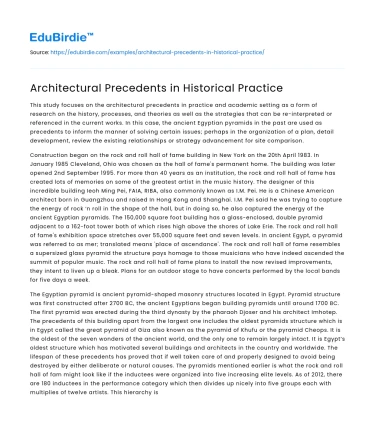Introduction
Architectural precedents have long served as fundamental cornerstones in the evolution of architectural practice. By examining the built environment of the past, architects glean insight into cultural, technological, and aesthetic shifts that have shaped human habitation and civic life. These precedents not only offer a repository of design knowledge but also provide a methodological framework through which contemporary challenges can be addressed. In this essay, the significance of architectural precedents in historical practice will be explored, emphasizing their role as instruments of continuity and innovation. The analysis will traverse various epochs, elucidating how historical precedents have informed modern architecture. Furthermore, counter-arguments challenging the reliance on precedents will be addressed, reinforcing the thesis that architectural history is indispensable to contemporary practice.
The Role of Precedents in Shaping Architectural Concepts
Architectural precedents serve as a critical foundation in shaping design concepts and solutions. These precedents often encapsulate responses to environmental, social, and technological challenges, providing a template for future architectural endeavors. For instance, the Roman aqueducts are emblematic of engineering prowess, showcasing a blend of functionality and aesthetic appeal. This historical precedent has informed modern water management systems, as noted by Vitruvius in his treatise, "The Ten Books on Architecture," which emphasizes the importance of studying past triumphs to inspire future innovation (Vitruvius, 1960).
Save your time!
We can take care of your essay
- Proper editing and formatting
- Free revision, title page, and bibliography
- Flexible prices and money-back guarantee
The use of precedents is not confined merely to replication but extends to adaptation, where architects reinterpret historical elements to suit contemporary contexts. The Beaux-Arts movement in the 19th century is a testament to this, as architects reimagined classical Greek and Roman motifs to express modern ideals of grandeur and civic pride. This adaptive approach has allowed architects to maintain a dialogue between the past and present, ensuring that buildings resonate with cultural memories while addressing current requirements. By understanding the historical significance and contextual relevance of precedents, architects can craft spaces that are both meaningful and functional.
Critics might argue that an over-reliance on precedents could stifle innovation, leading to derivative designs that lack originality. However, this perspective overlooks the potential of precedents to inspire creativity. As architectural theorist Kenneth Frampton articulates, "The past is not a box of dead bones, but a living entity that continues to evolve through reinterpretation" (Frampton, 1995). Therefore, the challenge lies in striking a balance between honoring historical legacies and pursuing novel architectural expressions.
Technological Innovations and Historical Influences
Technological advancements frequently intersect with historical influences to forge new architectural paradigms. The Industrial Revolution is a prime example, where the advent of steel and glass transformed architectural practices. These materials facilitated the creation of structures such as the Crystal Palace, designed by Joseph Paxton in 1851, which merged traditional design elements with cutting-edge technology. This synthesis of past and present is a recurring theme in architectural history, underscoring the relevance of precedents in navigating technological transitions.
Furthermore, contemporary sustainable design practices often draw upon historical precedents to address environmental challenges. The vernacular architecture of regions like the Middle East, characterized by features like wind towers and courtyards, offers valuable insights into passive cooling techniques. These precedents inform modern sustainable architecture, as seen in projects like the Masdar City in the United Arab Emirates, which integrates traditional methods with modern technology to achieve energy efficiency.
While some critics may view the adherence to historical practices as a hindrance to technological progress, this perspective fails to recognize the synergistic potential of integrating past insights with modern innovations. As architectural historian Spiro Kostof asserts, "History is a guide to navigation in perilous times. History is who we are and why we are the way we are" (Kostof, 1985). By leveraging historical precedents, architects can navigate the complexities of technological advancement while honoring cultural heritage.
Conclusion
In conclusion, architectural precedents play an indispensable role in historical practice, serving as catalysts for both continuity and innovation. By drawing upon the wealth of knowledge embedded within historical structures, architects can address contemporary challenges with informed creativity. While counter-arguments suggest that precedents may constrain originality, the evidence demonstrates their potential to inspire novel solutions. As we continue to confront new social, environmental, and technological demands, the lessons of the past will remain vital, guiding architects in the creation of spaces that are both reflective of historical legacies and responsive to modern needs. Thus, the study of architectural precedents is not merely a retrospective exercise but an essential component of progressive architectural practice.






 Stuck on your essay?
Stuck on your essay?

